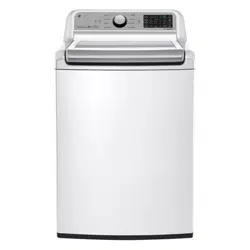Documents: Go to download!
User Manual
- Owner's manual - (English, Spanish)
- CA Prop 65 - (English)
- Energy Guide - (English)
- Dimensions Guide - (English)
- SAFETY INSTRUCTIONS
- PRODUCT OVERVIEW
- INSTALLATION
- OPERATION
- Control Panel
- Wash Cycles
- Cycle Guide
- MAINTENANCE
- TROUBLESHOOTING
Table of contents
User Gudie LG WT7800CW Washer
SAFETY INSTRUCTIONS
INSTALLATION
Adhere to all industry recommended safety procedures including the use of long-sleeved gloves and safety glasses.
- Never attempt to operate this appliance if it is damaged, malfunctioning, partially disassembled, or has missing or broken parts, including a damaged cord or plug.
- Before use, the appliance must be properly installed as described in this manual.
- To reduce the risk of severe injury or death, follow all installation instructions.
- Refer to the INSTALLATION INSTRUCTIONS for detailed grounding procedures. Installation instructions are packed with the appliance for the installer’s reference. If the appliance is moved to a new location, have it checked and reinstalled by qualified service personnel.
- Moving or installation of the appliance requires two or more people.
- Do not install the appliance in humid spaces.
- Store and install the appliance where it will not be exposed to temperatures below freezing or exposed to outdoor weather conditions.
- This appliance is not designed for maritime use or for mobile installations such as in RVs, trailers, or aircraft.
OPERATION
- Read all instructions before using the appliance and save these instructions.
- Use this appliance only for its intended purpose.
- If the product has been submerged, contact an LG Electronics customer information center for instructions before resuming use.
- If you detect a strange sound, a chemical or burning smell, or smoke coming from the appliance, unplug it immediately, and contact an LG Electronics customer information center.
- Under certain conditions, hydrogen gas may be produced in a hot-water system that has not been used for two weeks or more. HYDROGEN GAS IS EXPLOSIVE. If the hot-water system has not been used for such a period, before using the appliance turn on all hot water faucets and let the water flow from each for several minutes. This will release any accumulated hydrogen gas. As the gas is flammable, do not smoke or use an open flame during this time.
- Do not reach into the washer if the tub or drum, agitator, or any interior parts are moving. Before loading, unloading, or adding items, press Start/Pause and allow the tub or drum to coast to a complete stop before reaching inside.
- This appliance is not intended for use by persons (including children) with reduced physical, sensory or mental capabilities, or lack of experience and knowledge, unless they have been given supervision or instruction concerning the use of the appliance by a person responsible for their safety.
- Do not allow children or pets to play on, in or with the appliance. Close supervision is necessary when the appliance is used near children or pets.
- Keep laundry products out of children’s reach. To prevent injury to persons, observe all warnings on product labels.
- Repair or immediately replace all power cords that have become frayed or otherwise damaged. Do not use a cord that shows cracks or abrasion damage along its length or at either end.
- Never unplug the appliance by pulling on the power cord. Always grip the plug firmly and pull straight out from the outlet.
- Do not use an extension cord or adapter with this appliance.
- Do not grasp the power cord or touch the appliance controls with wet hands.
- Do not modify or extend the power cord.
MAINTENANCE
- Do not repair or replace any part of the appliance. All repairs and servicing must be performed by qualified service personnel unless specifically recommended in this owner’s manual. Use only authorized factory parts.
- Disconnect this appliance from the power supply before cleaning and attempting any user maintenance.
- Turning the controls to the OFF position does not disconnect this appliance from the power supply.
- Remove any dust or foreign matter from the power plug pins.
- Do not disassemble or repair the appliance by yourself.
- Remove the lid (door) before the appliance is removed from service or discarded to avoid the danger of children or small animals getting trapped inside.
- Make sure the dispenser drawer or lid (door) is closed at all times when not being filled with laundry products.
GROUNDING INSTRUCTIONS
- Improper connection of the equipment-grounding conductor can result in a risk of electric shock. Check with a qualified electrician or service personnel if you are in doubt whether the appliance is properly grounded.
- Do not modify the plug provided with the appliance; if it will not fit the outlet, have a proper outlet installed by a qualified electrician.
- The appliance must be grounded. In the event of a malfunction or breakdown, grounding will reduce the risk of electric shock by providing a path of least resistance for electric current.
- The appliance is equipped with a cord having an equipment-grounding conductor and a grounding plug. The plug must be plugged into an appropriate outlet that is installed and grounded in accordance with all local codes and ordinances.
PRODUCT OVERVIEW
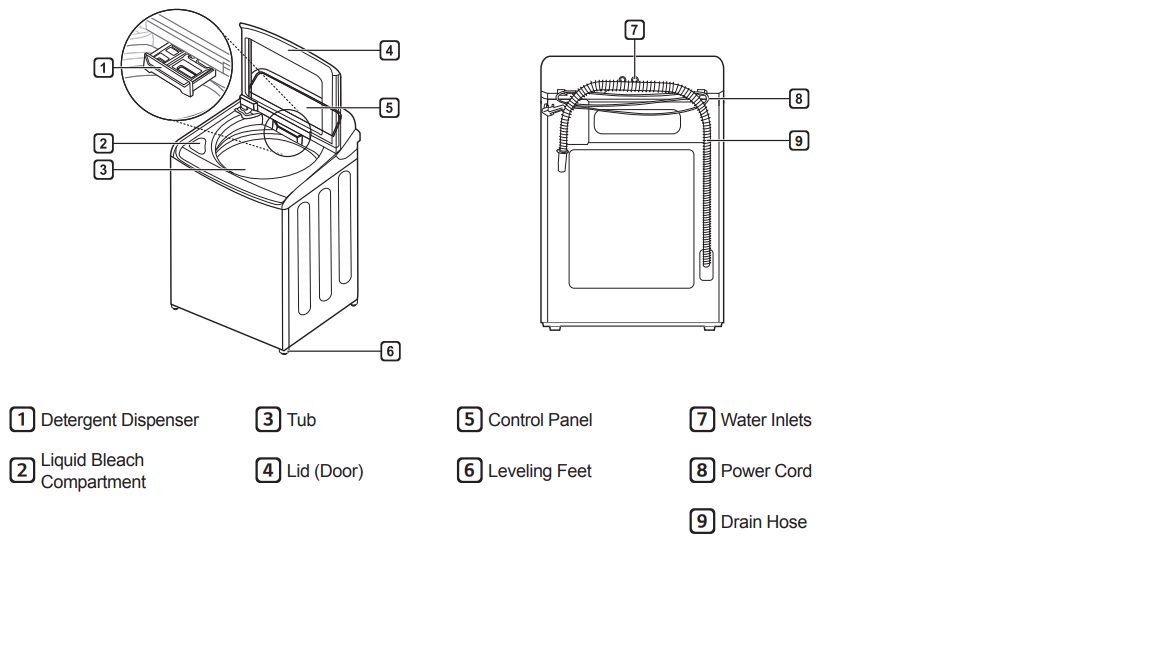
NOTE
• The images in this guide may be different from the actual components and accessories, which are subject to change by the manufacturer without prior notice for product improvement purposes.
• For your safety and for extended product life, use only authorized components. The manufacturer is not responsible for product malfunction or accidents caused by the use of separately purchased unauthorized components or parts.
INSTALLATION
Power Outlet
- The power outlet must be within 60 inches (1.5 m) of either side of the washer.
- The appliance and outlet must be positioned so that the plug is easily accessible.
- Do not overload the outlet with more than one appliance.
- The outlet must be grounded in accordance with current electrical wiring codes and regulations.
- Use a time-delay fuse or circuit breaker.
NOTE
- It is the personal responsibility and obligation of the product owner to have a proper outlet installed by a qualified electrician.
Flooring
- To minimize noise and vibration, the washer must be installed on a solidly constructed floor.
- Allowable slope under the entire washer is a maximum 1 inch difference from side to side or from front to back.
- Installing on carpeting and soft tile surfaces is not recommended.
- Never install the washer on a platform or weakly supported structure.
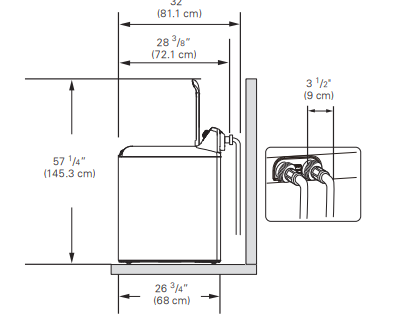
Floor Installation
- To ensure sufficient clearance for water lines, the drain line and airflow, allow minimum clearances of at least 1 inch (2.5 cm) at the sides and 4 inches (10 cm) behind the unit.
- Be sure to allow for wall, door, or floor moldings that may increase the required clearances.
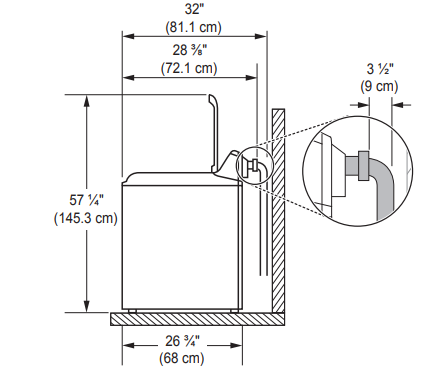
Connecting the Water Lines
- To avoid the risk of costly water damage, purchase and install new inlet hoses when installing the washer.
- Check the fittings and seals.
- Inspect the threaded fitting on each hose and make sure there is a rubber seal in place in both ends of each hose to prevent leaking.
Rubber seal Rubber seal
- Water hose (to water inlet on washer)
- Water hose (to tap)
Connect the water supply hoses.
- Connect the water supply hoses to the hot and cold water faucets tightly by hand and then tighten another 2/3 turn with pliers. Connect the blue hose to a cold water faucet and the red hose to a hot water faucet.
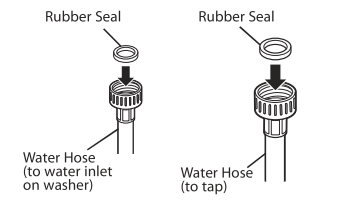

Flush out the inlet hoses.
- After connecting the inlet hoses to the water faucets, turn on the water faucets to flush out foreign substances (dirt, sand or sawdust) in the water lines. Let water drain into a bucket, and check the water temperature to make sure you've connected the hoses to the correct faucets.
- Attach the water lines to the back of the washer.
- Attach the hot water line to the hot water inlet on the back of the washer. Attach the cold water line to the cold water inlet on the back of the washer.
- Tighten the fittings securely. Turn ON both faucets all the way and check for leaks at both ends of the hoses.
NOTE
- Periodically check the hoses for cracks, leaks, and wear, and replace the hoses every five years. Do not stretch the water hoses intentionally, and make sure that they are not pinched, crushed or kinked by other objects.
- Water supply pressure must be between 20 psi and 120 psi (138 – 827 kPa). If the water supply pressure is more than 120 psi, a pressure reducing valve must be installed.
- To provide optimum washing performance, the hot water temperature should be set at 120 – 135 °F
- C) and the cold at 60 °F (15 °C).
- The washer should never be installed or stored in a location subject to freezing temperatures. Damage to the water lines and internal mechanisms of the washer can result. If the washer was exposed to freezing temperatures prior to installation, allow it to stand at room temperature for several hours before use and check for leaks prior to operation.
- Do not use flood-preventing hoses with auto shutoff devices. The devices can be tripped during fill and prevent the machine from filling properly
Connecting the Drain Hose
- Connect the drain hose to either a standpipe or laundry tub.
NOTE
- The drain hose should always be properly secured.
- Failure to properly secure the drain hose can result in flooding and property damage.
- The drain must be installed in accordance with any applicable local codes and regulations.
- Make sure that the drain hose is not stretched, pinched, crushed, or kinked.
- Do not install the drain hose with the end lower than inches (75 cm) or higher than 96 inches (244 cm) above the bottom of the washer or more than inches (152 cm) away from the washer.
- Never create an airtight seal between the hose and the drain with tape or other means. If no air gap is present, water can be siphoned out of the tub resulting in poor wash/rinse performance or clothing damage.
- Normal height of the end of the hose should be approximately 35 inches (89 cm) to 47 inches (120 cm) from the floor.
Leveling the Washer
- The tub of the washer spins at very high speeds. To minimize vibration, noise, and unwanted movement, the floor must be a level, solid surface.
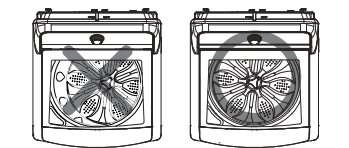
NOTE
- Adjust the leveling feet only as far as necessary to level the washer. Extending the leveling feet more than necessary can cause the washer to vibrate.
- Before installing the washer, make sure that the floor is clean, dry and free of dust, dirt, water and oil so the washer feet cannot slide easily. Feet that move or slide on the floor can contribute to excessive vibration and noise due to poor contact with the floor.
Position the washer in its final location.
- Take special care not to pinch, strain, or crush the water and drain lines. If you have a carpenter’s level, you can use it to check that the washer is level.
- The slope beneath the washer should not exceed 1 inch, and all four leveling feet must rest firmly on the floor.
Level
- Open the lid (door) and look from above to see if the tub is centered.
- If the tub is NOT centered, readjust the front feet.
- If you have a level, check the washer with the level.
NOTE
- To check if the washer is level from side to side, place a level on the back edge of the lid (door).
- To check if the washer is level from front to back, place a level at the side of the washer on the edge where the cabinet side meets the top cover.
- Do not place the level on the top of the lid (door).
- Using these surfaces will result in the washer being unlevel.
Level from side to side
- Level from front to back
- Adjust the lower leveling feet.
- Turn in one direction to raise the washer or the other direction to lower it.
Raise Lower
- Recheck the washer’s levelness.
- Push or rock the top edges of the washer gently to make sure the washer does not rock. If the washer rocks, repeat steps 1-3.
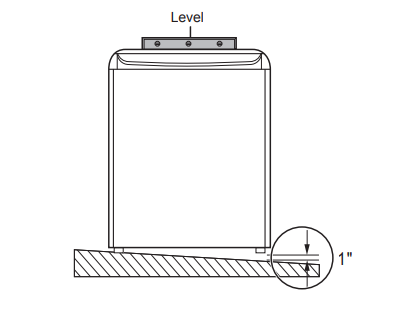
Testing the Washer
- Check if the washer is properly installed and run a test cycle.
- Make sure the tub is empty. Do not load anything in the tub for this test.
- Press the Power button then immediately press and hold both the Spin and Soil buttons until an code appears in the display. (See below for a key to the codes.)
- Press the Start/Pause button.
- The washer will start the test, which will last about minutes. The test automatically checks the water inlet hoses and the drain hose.
- Check the display for results.
- If error code is displayed, refer to the following guide.'
For the best washing results, and to reduce the possibility of damage to clothing, care should be taken to sort the clothing into loads that are made up of similar items. Mixing different fabric types and/or soil levels can result in poor wash performance, color transfer, discoloration, fabric damage or linting. Fabrics should be sorted into groups as described below.
Sort articles by color. Wash dark clothes together in a separate load from light colors or whites. Mixing dark clothes with light clothes can result in dye transfer or discoloration of the lighter clothes.
Wash heavily soiled clothing together. Washing lightly soiled clothing in the same load with heavily soiled clothing could result in poor wash performance for the lightly soiled clothing.
Delicate articles should not be mixed with heavier or sturdier fabric types. Washing heavier fabrics in a delicate load can result in poor wash performance for the heavier fabrics and possible damage to the delicates.Some fabrics attract and bind lint to them while others give off lint in the laundry process. Avoid mixing these lint collectors and lint producers in the same load. Mixing these fabrics will result in pilling and linting on the lint collectors. (For example, lint collector – knit sweater; lint producer – terry cloth towels.)
OPERATION
Sort laundry and load the washer.
- Sort laundry by fabric type, soil level, color and load size, as needed. Open the lid (door) and load items into the washer.
Add cleaning products.
- Add the proper amount of HE (High-Efficiency) detergent to the detergent dispenser. If desired, add bleach or fabric softener to the appropriate dispensers.
Turn on the washer.
- Press the Power button to turn on the washer.
- The lights above the cycle buttons will illuminate and a chime will sound.
Select a cycle.
- Turn the cycle selector knob or press the cycle buttons repeatedly until the desired cycle is selected. The preset wash temperature, spin speed, soil level and option settings for that cycle are shown.
- Pressing the Start/Pause button without selecting a cycle will cause the Normal cycle to begin immediately.
Adjust settings.
- Default settings for the selected cycle can now be changed, if desired, using the cycle modifier and option buttons.
NOTE
- Not all modifiers and options are available on all cycles. A different chime sounds and the LED does not light up if the selection is not allowed.
- Begin cycle.
- Press the Start/Pause button to begin the cycle.
- The lid (door) locks, and the washer agitates briefly without water to measure the weight of the load.
- Additional garments can be added to the tub while the Add Garment light is on.
- The Add Garment light illuminates near the beginning of the wash cycle to indicate when it is safe to add items to the load. Press the
- Start/Pause button to pause the cycle and add garments to the load. Press the Start/Pause button to resume the cycle.
NOTE
- Adding items after the Add Garment light turns off may result in poor wash performance.
- End of cycle.
- When the cycle is finished, a melody sounds.
- Immediately remove the clothing from the washer to reduce wrinkling.
- If the washer includes lint filters, remember to check them after every 2 to 3 loads.
Grouping Similar Items
- For the best washing results, and to reduce the possibility of damage to clothing, care should be taken to sort the clothing into loads that are made up of similar items.
- Mixing different fabric types and/or soil levels can result in poor wash performance, color transfer, discoloration, fabric damage or linting. Fabrics should be sorted into groups as described below.
Colors
- Sort articles by color. Wash dark clothes together in a separate load from light colors or whites. Mixing dark clothes with light clothes can result in dye transfer or discoloration of the lighter clothes.
Soil Level
- Wash heavily soiled clothing together. Washing lightly soiled clothing in the same load with heavily soiled clothing could result in poor wash performance for the lightly soiled clothing.
Fabric Type
- Delicate articles should not be mixed with heavy or sturdy fabric types. Washing heavy fabrics in a delicate load can result in poor wash performance for the heavy fabrics and possible damage to the delicates.
Lint Type
- Some fabrics attract and bind lint to them while others give off lint in the laundry process. Avoid mixing these lint collectors and lint producers in the same load.
- Mixing these fabrics will result in pilling and linting on the lint collectors. (For example, lint collector—knit sweater; lint producer—terry cloth towels.)
Sort Laundry
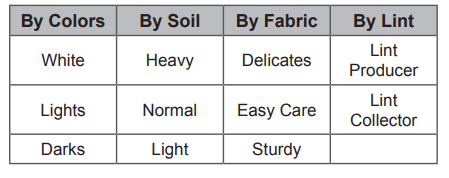
Loading the Washer
- Check and empty pockets. Paper clips, coins, matches, etc. can damage clothing and the washer.
- Close zippers and hooks, and tie drawstrings to prevent snagging or tangling of clothes.
- Pretreat heavily stained areas for best results.
- Combine large and small items in a load. Load large items first. Large items should not be more than half of total load.
- Wash thick, bulky items individually. Heavy blankets, comforters, bedspreads, or pet beds can get tangled or cause an unbalanced load if combined with other items.
- The washer can be fully loaded, but the tub should not be tightly packed with items. The lid (door) of the washer must close easily.
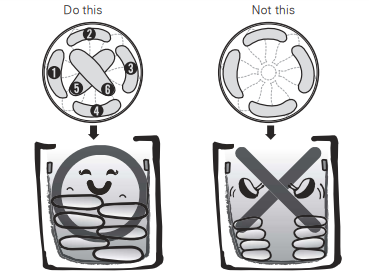
- Do not wash single small items. Add 1-2 similar items to the load to prevent an out-of-balance load.
- Clothing or articles that are waterproof or water resistant must be washed in the Waterproof cycle only. (e.g. water resistant clothing, mattress covers, outdoor clothes, plastic mats, etc.) Otherwise, it may result in personal injury or damage to the washer, clothes, walls, floor, and surrounding objects due to abnormal vibration.
- Wash small, light items in a mesh bag. Small items can get caught in the impeller at the bottom of the tub, and brassiere hooks can damage other items or the tub.
- Brush off heavy soil, dust, and hair from items before washing. Excess dirt or sand can abrade other fabrics and lead to poor wash performance.
- The washer will not fill or operate with the lid (door) open.
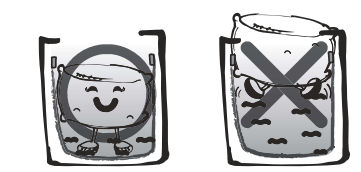
Using the Detergent and Softener
- Dispensers
- To add detergent and fabric softener to the automatic dispenser:
- Open the dispenser drawer.
- Load the laundry products into the appropriate compartments.
- Liquid fabric softener compartment
- Main wash liquid detergent compartment

Insert
- Main wash powder detergent compartment
- Close the drawer completely before starting the cycle.
- Be careful not to catch a hand in the drawer while closing.
Main Wash Detergent Compartment
- This compartment holds laundry detergent for the main wash cycle. Either powdered or liquid detergent may be used in this compartment.
- The detergent is added to the load at the beginning of the cycle.
- Always use HE (High-Efficiency) detergent with your washer.
NOTE
- Never exceed the manufacturer’s recommendations when adding detergent. Using too much detergent can result in detergent buildup in clothing and the washer.
- When using liquid detergent, make sure the liquid detergent compartment and insert are in place. Do not exceed the maximum fill line.
- When using powdered detergent, remove the insert and liquid detergent compartment from the dispenser. Powdered detergent will not dispense with the liquid detergent compartment and insert in place.
- If you use a detergent that does not dissolve easily or a detergent with high viscosity, it will leave a residue and clog the dispenser.
- Fabric Softener Compartment
- This compartment holds liquid fabric softener, which is automatically dispensed during the final rinse cycle.
NOTE
- Do not exceed the manufacturer’s recommendations when adding softener. Using too much fabric softener can result in buildup in clothing and the washer. Either powdered or liquid fabric softener may be used.
- Follow the manufacturer’s recommendations when adding fabric softener. Do not exceed the maximum fill line. Using too much fabric softener may stain clothes.
- Dilute concentrated fabric softeners with warm water.
- Never pour fabric softener directly onto the load or into the tub.
Using the Liquid Bleach Dispenser
- The bleach dispenser is a separate compartment at the left front of the tub opening.
Type 1
- The bleach dispenser is connected to the inlet valve.
- The bleach is automatically diluted and dispensed at the proper time in the wash cycle.
NOTE
The dispenser is activated twice to ensure complete dispensing of the bleach. Any liquid remaining in the dispenser at the end of the cycle is water, not bleach.
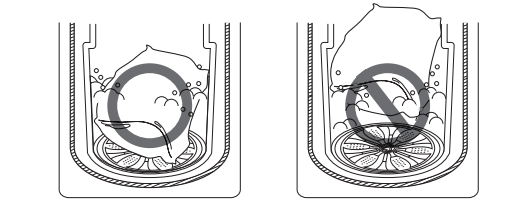
Detergent Use
- This washer is designed for use with only HE (HighEfficiency) detergents. HE detergents produce fewer suds, dissolve more efficiently to improve washing and rinsing performance, and help to keep the interior of the washer clean. Using detergent that is not HE may cause oversudsing and unsatisfactory performance which could result in error codes, cycle failure, and machine damage.
- For proper wash performance, always measure detergent using the measuring device provided by the detergent manufacturer. For an average load, use less than half of the recommended maximum.
- Use less detergent for soft water, light soil, or smaller loads.
- Never use more than the maximum amount of detergent recommended by the manufacturer. Using too much detergent can lead to oversudsing, poor rinsing, detergent buildup in clothing, and residue buildup that can contribute to odors in the machine.
- Use extra care when measuring 2X and 3X concentrated detergents because even a small amount extra can lead to problems.
- Detergents designated as HE-compatible may not provide optimal results.
- Do not use more than one detergent pod in the washer. Using too much detergent may cause oversudsing and unsatisfactory performance.
- Reduce detergent amount or add an extra rinse if detergent residue is left on fabrics. To add an extra rinse, press the Extra Rinse button.
Control Panel
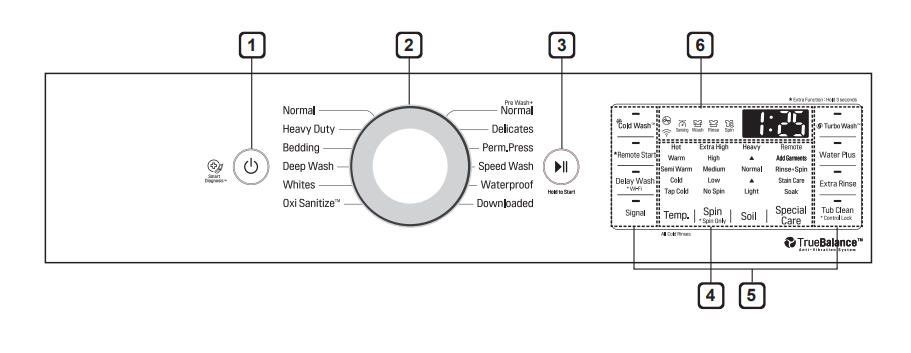
Power On/Off Button
- Press to turn the washer on. Press again to turn the washer off. Pressing the Power button during a cycle will cancel that cycle and any load settings will be lost. The lid (door) will unlock after a brief pause.
NOTE
- If there is any water remaining in the tub after the washer shuts off, it will drain following 4 minutes delay.
- The washer can be restarted any time before the drain begins. However, once the water begins to drain, all functions will be suspended until the water has been completely drained and the washer shuts off.
Cycle Selector Knob
- Turn this knob to select the desired cycle.
- Once the desired cycle has been selected, the standard presets will appear in the display. These settings can be adjusted using the cycle modifier buttons anytime before starting the cycle.
NOTE
- To protect your clothing, not all settings are available on all cycle selections.
Start/Pause Button
- Press this button to start the selected cycle. If the washer is running, use this button to pause the cycle without losing the current settings.
NOTE
- If Start/Pause is not pressed within 60 minutes of selecting a cycle, the washer automatically turns off and all cycle settings are lost. Any water remaining in the tub will be drained.
Cycle Modifier Buttons
- Use these buttons to adjust the water temperature, spin speed and soil level settings for the selected cycle. The current settings are shown in the display. Press the button for that option to select other settings.
Special Cycle and Option Buttons
- Press these buttons to select special cycles or additional cycle options. Certain buttons also allow you to activate special functions by pressing and holding the button for three seconds.
Time and Status Display
- The display shows the settings, estimated time remaining, options, and status messages for your washer. When the washer is turned on, the default settings in the display will illuminate.
Door Lock Indicator
- The Door Lock indicator will light up once a cycle has started. The indicator light will stay on until the cycle is paused, stopped or has finished.
Wi-Fi Connect Indicator
- The indicator blinks during product registration and Wi-Fi setup and illuminates when the appliance is connected to a home Wi-Fi network.
Cycle Status Indicator
- These LEDs illuminate when a cycle is selected to indicate which stages are included. When a cycle is running, the LED for the active stage blinks, and the LEDs for the remaining stages remain steady.
- Once a stage is complete, the LED turns off. If a cycle is paused, the active stage LED stops blinking.
Estimated Time Remaining
- When a cycle is selected, the default time for that cycle is displayed. This time will change as modifiers or options are selected. Once the
- Start/Pause button is pressed, the washer will measure the size of the load. The estimated time may change once the load size has been measured. If Delay Wash is set, the remaining delay time counts down until the cycle begins.
NOTE
- The time shown is only an estimate. This time is based on normal operating conditions. Several external factors (load size, room temperature, incoming water temperature,etc.) can affect the actual time.
Wash Cycles
- Wash cycles are designed for the best wash performance for each type of load. Select the cycle that best matches the load contents for maximum wash performance and fabric care.
- See the Sorting Laundry section for best results, follow the fabric care labels on your garments.
- For a guide to fabric care symbols, see the Sorting Laundry section. Turn the knob or press the button to select the desired cycle. When you select a wash cycle, the light for the corresponding wash cycle will turn on.
Normal
- Use this cycle to wash all normal items, except delicate fabrics such as wool or silk.
- Fabric type : Cotton, linen, shirts, jeans, mixed loads
- Pressing the Start/Pause button without selecting a cycle will cause the Normal cycle to begin immediately, using the default settings.
Heavy Duty
- This cycle is for washing heavily soiled laundry using more powerful wash motions.
- Fabric type : Heavily soiled cotton fabrics
- When washing large loads, in order to deliver the best performance, there will be brief periods of minutes or more without agitation. These soak periods are part of the cycle’s design, and are normal.
Bedding
- This cycle is for washing blankets or bulky items.
- Fabric type : Large items such as blankets, comforters, and sheets
- Do not use this cycle to wash a mixed load of bedding and non-bedding items.
- Use this cycle for items such as pillows, comforters, pet bedding and other articles which have difficulty absorbing water.
- Do not wash excessively large items. If large/bulky items do not fit easily into the tub, there may not be enough room for them to move during washing.
- Keep like items together; do not mix large/bulky items with smaller articles of clothing.
Deep Wash
- Use this cycle to provide addtional water and wash heavily soiled mixed items, except delicate fabrics.
Whites
- This cycle is for washing white items only.
- Fabric type : Underwear, pillow covers, bed sheets, baby wear. (less than 12 lbs.)
Oxi Sanitize™
- This wash cycle offers hygienic care for laundry when used in conjunction with bleach, without high energy consumption.
- Fabric type : Cotton, underwear, pilow covers, bed sheets, baby-clothing. less than 11lbs.)
- Follow the product manufacturer’s instructions for using Oxi products with this cycle.
- Never load powdered products into the liquid bleach dispenser. Doing so can result in the product not being dispensed or being dispensed incorrectly. Powders can clog the bleach dispenser, resulting in leaks or damage to the washer or your clothing.
Cycle Guide

Cycle Modifier Buttons
- Each cycle has default settings that are selected automatically. You may also customize these settings using the cycle modifier buttons.
- Press the button for the desired modifier until the indicator light for the desired setting is lit.
- The washer automatically adjusts the water level for the type and size of wash load for best results and maximum efficiency.
- Due to the high-efficiency nature of this product, water levels may be much lower than expected. This is normal and cleaning/rinsing performance will not be compromised.
NOTE
- To protect your garments, not every wash temperature, spin speed, soil level, or option is available with every cycle. A chime will sound and the LED will not light if a selection is not allowed.
Temp.
- Temp. selects the wash and rinse temperature combination for the selected cycle.
- Press the Temp. button until the indicator light for the desired setting is lit.
- All rinses use tap cold water.
NOTE
- Select the water temperature suitable for the type of load you are washing. Follow the fabric care labels on the garment for best results.
Spin
- Higher spin speeds extract more water from clothes, reducing drying time and saving energy.
- Press the Spin button until the desired speed is selected.
- Some fabrics, such as delicates, require a slower spin speed. To protect your clothing, not all spin speeds are available for all cycles.
Soil
- Adjusting the soil level setting will modify the cycle times and/or wash actions.
- Press the Soil button until the desired soil level is selected.
NOTE
- This feature needs more time for heavily soiled loads or less time for lightly soiled loads.
Special Care
- Press the Special Care button to select additional features, such as Soak, Stain Care, and Rinse+Spin.
- Pressing the Special Care button before selecting a cycle will automatically default to the Normal cycle with the Soak feature selected.
Special Care Features
- Press the Special Care button to select specialized cycles or add features to standard cycles. Press the button repeatedly to move through the available features.
NOTE
- To protect your garments, not every feature is available with every cycle.
- If the Start/Pause button is not pressed within 60 minutes to start the cycle, the washer will shut off and all settings will be lost.
Soak
- This option provides a 30-minute presoak prior to the start of the selected cycle. Use the Soak option to presoak garments to help remove difficult spots or stains on fabrics.
- At the end of the presoak time, the selected cycle will begin with the same water used for the soak.
NOTE
- You cannot select the Soak option for the Tub Clean cycle.
Stain Care
- Use this option for heavily soiled loads that need improved stain treatment. When Stain Care is selected, the wash cycle will begin with warm water to help prevent the setting of certain types of stains.
- Then, as the cycle progresses, hot water will be added to gradually increase the water temperature to help remove stains that require treatment at higher temperatures.
NOTE
- Best results are obtained with smaller loads (less than 6 lb.)
- If you select Stain Care, the Cold Wash option is not available.
Rinse+Spin
- Select this option to rinse and spin a load separately from a regular cycle. This can be helpful in preventing fresh stains from setting in fabrics. You can change the spin speed by pressing the Spin button.
- Press the Power button to turn on the washer.
- Press the Special Care button repeatedly until
- Rinse+Spin is selected.
- Press the Start/Pause button.
Special Drain Feature
- This washer is equipped with a special drain feature that is designed to make your washer as safe as possible. If the washer is paused or shut off while there is still water in the tub, the water will drain automatically after several minutes of inactivity. This helps keep children safe by reducing the possibility of water remaining in the tub.
- Any water remaining in the tub will automatically drain minutes after the washer has shut off. If the washer is paused and the Start/Pause button is not pressed within 60 minutes, the washer will shut off and all cycle settings will be lost. And any water remaining in the tub will be drained.
- The washer can be turned on or restarted any time before the drain begins. However, once the washer begins to drain, all controls and functions will be disabled until the water has been completely drained and the washer shuts off.
Add Garments
- If you’ve forgotten to add an item or need to remove foreign objects like coins or keys after the cycle has started, the best time to do so is while the Add
- Garments indicator is on. Once the indicator turns off, adding garments may affect the cycle time or wash performance.
- Press Start/Pause. The cycle pauses and the lid (door) unlocks.
- Open the lid (door), add garments or remove foreign objects, and close the lid (door).
- Press the Start/Pause button to start the cycle.
- The cycle continues automatically
Turbo Wash™
- Adding the Turbo Wash™ option to a cycle reduces the length of the cycle while maintaining a similar wash performance.
NOTE
- The Turbo Wash™ option cannot be used with all cycles.
- Turbo Wash™ defaults On for Normal, Pre
- Wash+Normal and Speed Wash cycles.
Water Plus
- Use this option to add extra water to the wash cycle for better wash performance (stain treatment) with large or bulky items.
NOTE
- If the washer reaches its maximum water level, the
- Water Plus button will have no effect.
- To add more water while a cycle is running, pause the cycle before pressing Water Plus.
- Selecting the Water Plus option with the Normal cycle automatically changes the cycle to the Deep
Extra Rinse
- This option will add an extra rinse to the selected cycle. Use this option to help ensure the removal of detergent or bleach residue from fabrics. Liquid fabric softener, if used, is always dispensed in the final rinse.
- Pressing the Extra Rinse button twice will add two additional rinses to the cycle.
NOTE
- You cannot select the Extra Rinse option with the
- Spin Only option and Tub Clean cycle.
- Selecting the Extra Rinse option with the Normal cycle automatically changes the cycle to the Deep
- Wash cycle.
- Tub Clean
- Use this cycle to clean the tub of your washing machine. See the Maintenance section.
MAINTENANCE
Care After Wash
- After the cycle is finished, wipe the lid (door) and the inside of the lid (door) seal to remove any moisture.
- Leave the lid (door) open to dry the tub interior.
- Wipe the body of the washer with a dry cloth to remove any moisture.
- Cleaning the Exterior
- Proper care of your washer can extend its life.
Lid (Door):
- Wash with a damp cloth on the outside and inside and then dry with a soft cloth.
Exterior:
- Immediately wipe off any spills.
- Wipe with a damp cloth.
- Do not touch the surface or the display with sharp objects.
- Care and Cleaning of the Interior
- Use a towel or soft cloth to wipe around the washer lid (door) opening and lid (door) glass.
- Always remove items from the washer as soon as the cycle is complete. Leaving damp items in the washer can cause wrinkling, color transfer, and odor.
- Run the Tub Clean cycle once a month, or more often if needed, to remove detergent buildup and other residue.
Cleaning the Tub
- Over time, residue may build up in the tub, leading to mildew or a musty odor. Run the Tub Clean cycle monthly to remove residue and prevent odor.
- Run the cycle more often under heavy use conditions or if odor is already present.
- Remove any clothing from the tub.
- Add cleaning agents.
Cleaner Instructions
- Tub cleaner Follow manufacturer’s
- Lime scale remover recommendations.
- Liquid chlorine bleach
- Add to main wash liquid detergent dispenser.
- Powdered cleaner Follow manufacturer’s recommendations.
- Cleaning tablets Place directly into washer tub.
- For other tub cleaning products, follow the cleaner manufacturer’s instructions and recommendations.
- Do not exceed the maximum fill line when adding bleach or powdered cleaners. Powdered cleaners may remain in the tub after cleaning.
- Close the lid (door) and press the Power button to turn the washer on.
- Turn the knob or press the cycle buttons to select the Tub Clean cycle then press the Start/Pause button to begin the cycle.
- After the cycle ends, open the lid (door) and allow the tub interior to dry completely
Removing Mineral Buildup
- In areas with hard water, mineral scale can form on internal components of the washer. Periodically clean the mineral buildup on the internal components to extend the lifespan of the washer. Use of a water softener is recommended in areas with hard water.
- Use a descaler, such as Washer Magic®, to remove visible mineral buildup on the washer tub.
- After descaling, always run the Tub Clean cycle before washing clothing.
- Mineral scale and other spots may be removed from the stainless steel tub using a soft cloth soaked in stainless steel cleaner.
- Do not use steel wool or abrasive cleaners.
Leaving the Lid (Door) Open
- If the washer will not be used for several days, leave the lid (door) open overnight to allow the tub to dry
Cleaning the Dispenser Drawer
- Detergent and fabric softener may build up in the dispenser drawer. Remove the drawer and inserts and check for buildup once or twice a month.
- Remove the drawer by pulling it straight out until it stops. Lift up on the front of the drawer and pull it completely out.
- Remove the inserts from the two compartments.
- Clean the inserts and drawer with warm water.
- Use a soft cloth or brush for cleaning and to remove any residue.
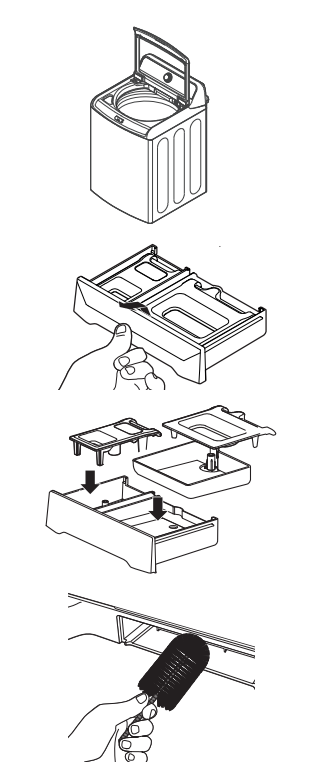
WARNING
- Do not spray water inside the washer. Doing so may cause fire or electric shock.
- Wipe off any moisture with a dry towel or cloth after cleaning.
- To clean the drawer opening, use a small, nonmetal brush to clean the recess. Remove all residue from the upper and lower parts of the recess.
- Return the inserts to the proper compartments and replace the drawer.
- Set the drawer into the opening at an angle, then lower it and slide it into place.
NOTE
- If you use a descaler or tub cleaner during the Tub
- Clean cycle, use the Rinse+Spin option to rinse the washer tub before running your next wash cycle.
- Cleaning the Bleach Dispenser
- Bleach may build up on the bleach dispenser cover.
- Check for buildup and clean the cover once or twice a month.
Type 1
- Remove the cover from the bleach dispenser. Clean the cover and the opening with warm water.
Type 2
- The cover cannot be separated from the dispenser.
- Clean the cover using a brush and warm water.
- Cleaning the Water Inlet
Filters
- If the washer does not fill properly, an error message will show on the display. The inlet valve filter screens could be plugged by hard water scale, sediment in the water supply, or other debris.
- Turn off both water faucets completely.
- Unscrew the hot and cold water hoses from the back of the washer.
- Carefully remove the filters from the water valves.
- Remove foreign objects and soak the filters in white vinegar or a lime scale remover.
- If using a lime scale remover, follow the manufacturer’s instructions. Be careful not to damage the filters while cleaning them.
- Rinse filters thoroughly and press them back into place.
- Flush then reattach the water hoses.
- Before reattaching the hoses, flush the hoses and water lines by running several gallons of water into a bucket or drain, preferably with the faucets wide open for maximum flow.
NOTE
- An message may blink on the display when the water pressure is low or an inlet filter is clogged with dirt. Clean the inlet filter
Storing the Washer
- If the washer will not be used for an extended period of time and is in an area that could be exposed to freezing temperatures, perform the following steps to protect the washer from damage.
- Make sure the tub is empty before following these steps.
- Turn off the water supply.
- Disconnect hoses from water supply and drain water from hoses.
- Plug the power cord into a properly grounded electrical outlet.
- Add 1 gallon of nontoxic recreational vehicle
- RV) antifreeze to the empty tub and close the lid door). Never use automotive antifreeze.
- Press the Power button, then select Spin.
- Press the Start/Pause button to start the drain pump.
- Allow the drain pump to run for one minute, then press the Power button to shut off the washer.
- This will expel some of the antifreeze, leaving enough to protect the washer from damage.
- Unplug the power cord, dry the tub interior with a soft cloth, and close the lid (door).
- Store the washer in an upright position.
- Remove the inserts from the dispenser. Drain any water in the compartments and let them dry.
- To remove the antifreeze from the washer after storage, run a complete Speed Wash cycle using detergent.
- Do not add laundry to this cycle.
When the Water Line is Frozen
- Turn off the faucets connected with the water lines.
- Pour hot water on the frozen faucets to thaw the water lines and remove water lines.
- Immerse the water lines in hot water to thaw them.
- Connect the water lines with the water inlets of the washer and with the faucets.
- See Connecting the Water Lines for details.
- Turn on the faucets.
Press the Power button.
- Press Special Care repeatedly to select the
- Rinse+Spin cycle.
- Press the Start/Pause button. Verify the water fills properly.
- When the Drain Line is Frozen
- Pour hot water in the washer tub and close the lid.
- Wait for 1-2 hours.
- Press the Power button after thawing.
- Press Special Care repeatedly to select the
- Rinse+Spin cycle.
- Press the Start/Pause button. Check to make sure the water drains.
TROUBLESHOOTING
Rattling and clanking noise
- Foreign objects, such as keys, coins, or safety pins may be in tub .
- Stop washer, check tub for foreign objects. If noise continues after washer is restarted, call for service.
Thumping sound
- Heavy wash loads may produce a thumping sound.
- This is normal. If sound continues, washer is probably out of balance. Stop and redistribute wash load.
- Wash load may be out of balance. Pause the cycle and redistribute the load after the lid unlocks.
Vibrating noise
- Packaging materials were not removed.
- See the Unpacking and Removing Shipping Material section in the installation requirements section.
Wash load may be unevenly distributed in the tub.
- Pause the cycle and redistribute the load after the lid unlocks.
- Not all leveling feet are resting firmly and evenly on the floor.
- See Leveling the Washer in the Installation Instructions section.
Floor not rigid enough.
- Make sure that the floor is solid and does not flex.
- See Flooring in the Installation Requirements section.
Water leaking
- Inlet hose connection is loose at faucet or washer.
- Check hoses for leaks, cracks and splits.
- Check and tighten hose connections.
- House drain pipes are clogged. The washer pumps out water very rapidly. Check for water backing up out of the drain pipe during drain. If water is seen coming out of the drain, check for proper drain hose installation and check for restrictions in the drain. Contact a plumber to repair drain pipe.
- Drain hose has come out of drain or is not inserted far enough.
- Tie drain hose to inlet hose or standpipe to prevent it from coming out during drain. For smaller drain pipes, insert the drain hose into the pipe as far as the drain hose flange. For larger drain pipes, insert the drain hose into the pipe 1-2 inches past the flange.
A large item such as a pillow or blanket is above the top of the tub.
- Use the BULKY/BEDDING cycle for large or bulky items.
- Use extra care and never wash more than half a load of items that float, such as pillows.
- Stop the washer and check the load.
- Make sure the load does not crest above the top edge of the tub.
- Wrinkling Washer not unloaded promptly. Always remove items from the washer as soon as the cycle is complete.
Washer overloaded.
- The washer can be fully loaded, but the tub should not be tightly packed with items. The lid of the washer should close easily.
- Hot and cold water inlet hoses are reversed.
- Hot water rinse can set wrinkles in garments.
- Check the inlet hose connections.
- Excessive sudsing Too much detergent or incorrect detergent.
- HE detergents are formulated specifically for High-Efficiency washers and contain suds-reducing agents. Only use detergent with the High-Efficiency (HE) logo. For detergent quantities refer to the How to Use section.
Staining Bleach or softener dispensed too soon.
- Dispenser compartment is overfilled causing bleach or softener to dispense immediately.
- ALWAYS measure bleach to prevent overfilling - one cup maximum.
- Dispenser drawer closed too quickly causing softener to dispense immediately.
- Bleach or softener was added directly to the wash load in the tub.
- Always use the dispensers to ensure that laundry products are properly dispensed at the right time in the cycle.Washer was not unloaded promptly.
- Always remove items from the washer as soon as possible after the cycle is complete.
- Clothes were not properly sorted. Always wash dark colors separately from light colors and whites to prevent discoloration.
- Never wash heavily soiled items washed with lightly soiled items.
Washer will not turn
- Power cord is not properly plugged in.
- Make sure that the plug is plugged securely into a grounded, 3-prong, 120-VAC, 60-Hz outlet.
- House fuse is blown, circuit breaker has tripped, or power outage has occurred.
- Reset circuit breaker or replace fuse. Do not increase fuse capacity. If the problem is a circuit overload, have it corrected by a qualified electrician.
Wash cycle time is longer than usual
- The washer automatically adjusts the wash time for the amount of laundry, water pressure and other operating conditions.
- This is normal. The washer adjusts cycle time automatically to provide optimal results for the selected cycle. The time remaining shown in the display is only an estimate. Actual time may vary.
- Musty or mildewy odor in washer
- Incorrect or too much detergent has been used.
- Use only High-Efficiency (HE) detergent in accordance with the manufacturer’s instructions.
- Inside of tub was not cleaned properly.
- Run the Tub clean cycle regularly.
Water leaks
- Oversudsing of detergent. Oversudsing may create leaks, and may be caused by the type and amount of detergent used.
- High-Efficiency detergent is the only detergent recommended. Make sure that detergent and any additives are put into the correct dispenser compartments.
- The normal amount of detergent to use is 1/4 to 1/2 of the maximum amount recommended by the detergent manufacturer. Always reduce the amount of detergent if the load is small or lightly soiled, or if your water is very soft. Never use more than the maximum amount recommended by the detergent manufacturer
Washer will not operate
- Control panel has powered off due to inactivity.
- This is normal. Press the POWER button to turn the washer on.
- Washer is unplugged. Make sure cord is plugged securely into a working outlet.
- Water supply is turned off. Turn both hot and cold faucets fully on.
- Controls are not set properly. Make sure the cycle was set correctly, close the lid and press the START/PAUSE button.
Lid is open
- The washer will not operate if the lid is open. Close the lid and make sure that nothing is caught under the lid preventing it from closing completely.
Circuit breaker/fuse is tripped/ blown.
- Check house circuit breakers/fuses. Replace fuses or reset breaker. The washer should be on a dedicated branch circuit. The washer will resume the cycle where it stopped once power is restored.
- Control needs to be reset. Press the POWER button, then re-select the desired cycle and press the START/PAUSE button.
- START/PAUSE was not pressed after a cycle was set.
- Press the POWER button then re-select the desired cycle and press the START/PAUSE button. The washer will shut off if the START/PAUSE button is not pressed within 60 minutes.
- Extremely low water pressure. Check another faucet in the house to make sure that household water pressure is adequate.
- START/PAUSE was not pressed after a cycle was set.
Washer is too cold.
- If the washer has been exposed to temperatures below freezing for an extended period of time, allow it to warm up before pressing the POWER button. Otherwise, the display will not come on.
Washer not filling properly
- Filter clogged. Make sure the inlet filters on the fill valves are not clogged. Refer to the filter cleaning instructions.
- Inlet hoses may be kinked.
- Check that inlet hoses are not kinked or clogged.Energy efficiency. This is a High Efficiency (HE) washer. As a result, the water level settings for this washer may be different than for conventional washers.
- Insufficient water supply. Make sure that both hot and cold water faucets are turned on all the way.
The washer lid is open.
- The washer will not operate if the lid is open.
- Close the lid and make sure that nothing is caught under the lid preventing it from closing completely.
Hot and cold inlet hoses are reversed.
- Check inlet hose connections.
- Make sure the hot water supply is connected to the hot inlet valve, and the cold water supply is connected to the cold inlet valve.
Water level is too low.
- This is a high efficiency washer. The water will not normally cover the clothes
- . The fill level is optimized for the wash motion to achieve the best wash performance.
Vibration, rocking, or “walking
- Feet may not be in contact with the floor and locked.
- Load could be unbalanced.
- Front and rear feet must be in firm contact with floor, and washer must be level to operate properly. See Installation Instructions.
- Washer may not be level. Check floor for flexing or sagging.
- If flooring is uneven, a ¾" (19 mm) piece of plywood under your washer will reduce sound. See “Level the Washer” in Installation Instructions.
Vibration during spinning or washer stopped
- Load could be unbalanced.
- Load items in loose heaps evenly around the washplate. Adding wet items to washer or adding more water to basket could unbalance washer.
- Avoid washing single items. Balance a single item such as a rug or jeans jacket with a few extra items. Redistribute the load, close the lid, and touch and hold the Start/Pause button.
- Use Bedding cycle for oversized, non-absorbent items such as jackets and small comforters.
- Item or load not suitable for selected cycle. See “Cycle Guide” and
- Using Your Washer” in this Use and Care Guide.
Clicking or metallic noises
- Objects may be caught in washer drain system.
- Empty pockets before washing. Loose items such as coins could fall between basket and tub or may block pump. It may be necessary to call for service to remove items.
- It is normal to hear metal items on clothing such as metal snaps, buckles, or zippers touch against the stainless steel basket.
Check the following for proper installation:
- Washer not level.
Water may splash off basket if washer is not level.
- Check that load is not unbalanced or tightly packed.
Fill hoses not attached tightly.
- Tighten fill-hose connection.
Fill hose washers. Make sure all four fill hose flat washers are properly seated.
- Drain hose connection.
Pull drain hose from washer cabinet and properly secure it to drainpipe or laundry tub. Do not place tape over drain opening.
- Check household plumbing for leaks or clogged sink or drain.
Water can back up out of a clogged sink or drainpipe.
- Check all household plumbing for leaks (laundry tubs, drain pipe, water pipes, and faucets.) Washer not loaded as recommended
Normal operation
- Spraying or hissing Water spraying or circulating during the cycle
Humming or Gurgling
- Drain pump is pumping water from the washer at times during a cycle.
- Normal operation
- Water sloshing A liquid in the balance ring around the pulsator helps the basket spin smoothly.
- Normal operation
- Water being added after the washer has already begun to operate
- The washer adapts to the load size and type to add more water to the cycle as needed.
- Normal operation
- The wash load may be unbalanced. If the washer senses that the load is unbalanced, it will stop and refill to redistribute the load.
- Normal operation
- The washer may be diluting laundry additives to add to the wash load.
- Normal operation
- Rattling and clanking noise
- Foreign objects, such as keys, coins, or safety pins may be in drum or pump.
- Stop the washer, check the drum and the drain filter for foreign objects.
- If noise continues after the washer is restarted, call for service.
- Thumping sound Heavy wash loads may produce a thumping sound.
- This is normal, but if the sound continues, the washer is probably out of balance. Stop and redistribute wash load.
Wash load may be out of balance.
- Pause the cycle and redistribute the load after the door unlocks.
- Vibrating noise Packaging materials were not removed.
- See Unpacking and Removing Shipping Material in INSTALLATION.
- Wash load may be unevenly distributed in the drum.
- Pause the cycle and redistribute the load after the door unlocks.
- Not all leveling feet are resting firmly and evenly on the floor.
- See Leveling the Appliance in INSTALLATION.
Floor is not rigid enough.
- Make sure that the floor is solid and does not flex. See Flooring in INSTALLATION.
- Squeaking noise Packaging materials were not removed.
- See Unpacking and Removing shipping Material in INSTALLATION.
Water Leaking
- Hoses are not connected correctly.
- Check hoses and connectors for leaks, cracks, and splits.
- Check and tighten hose connections.
- House drain pipes are clogged.
- The washer pumps out water very rapidly. Check for water backing up out of the drain pipe during drain. If water is seen coming out of the drain, check for proper drain hose installation and check for restrictions in the drain.
- Contact a plumber to repair drain pipe.
- Drain hose has come out of the drain connector or is not inserted far enough.
- Tie drain hose to inlet hose or standpipe to prevent it from coming out during drain.
- For smaller drain pipes, insert the drain hose into the pipe as far as the drain hose flange.
- For larger drain pipes, insert the drain hose into the pipe 1 - 2 inches past the flange.
- Oversudsing of detergent
- Oversudsing may create leaks, and may be caused by the type and amount of detergent used. HE (High-Efficiency) detergent is the only detergent recommended. The normal amount of detergent to use is 1/4 to 1/2 of the maximum amount recommended by the detergent manufacturer.
- Always reduce the amount of detergent if the load is small or lightly soiled, or if the water is very soft.
- Never use more than the maximum amount recommended by the detergent manufacturer.
Excessive sudsing
- Too much detergent or incorrect detergent
- HE detergents are formulated specifically for HE (High-Efficiency) washers and contain suds reducing agents. Only use detergent with the HE (High-Efficiency) logo.
- For detergent quantities refer to Detergent Use in OPERATION. If sudsing or detergent residue continues to be an issue, add an extra rinse.
Washer will not turn on.
- Power cord is not properly plugged in.
- Make sure that the plug is plugged securely into a grounded, 3-prong, 120-VAC, 60 Hz outlet.
- House fuse is blown, circuit breaker has tripped, or power outage has occurred.
- Reset circuit breaker or replace fuse. Do not increase fuse capacity. If the problem is a circuit overload, have it corrected by a qualified election.
Wash cycle time is longer than usual.
- The washer automatically adjusts the wash time for the amount of laundry, water pressure and other operating conditions.
- This is normal. The washer adjusts cycle time automatically to provide optimal results for the selected cycle. The time remaining shown in the display is only an estimate. Actual time may vary
Incomplete or no dispensing of detergent
- Detergent compartments clogged from incorrect filling.
- Make sure that detergent and additives are put into the correct dispenser compartments.
- For all detergent types, always make sure that the dispenser drawer is fully closed before the start of the cycle.
- Too much detergent used.
- Make sure that the suggested amount of detergent is used according to the manufacturer’s recommendations. You may also dilute the detergent with water to the maximum fill line on the compartment to avoid clogging. Use only HE (High-Efficiency) detergent.
NOTE
- Always use as little detergent as possible. HE (High-Efficiency) washers need very little detergent to achieve optimum results. Using too much detergent will cause poor wash and rinse performance and may contribute to odors in the washer.
- Insufficient water supply
- Make sure that both hot and cold water faucets are turned on all the way.
- Normal residue
- It is normal for a small amount of detergent to remain in the dispenser. If this residue builds up, it can interfere with normal dispensing of detergents. Refer to the cleaning instructions.
Washer will not operat
- Control panel has powered off due to inactivity.
- This is normal. Press the Power button to turn on the washer.
- Washer is unplugged.
- Make sure that the power cord is plugged securely into an electrical outlet.
- Water supply is turned off.
- Turn both hot and cold faucets fully on.
- Controls are not set properly.
- Make sure that the cycle was set correctly, close the door and press the Start/Pause button to start the wash cycle.
- Door is open.
- Close the door and make sure that nothing is caught under the door preventing it from closing completely.
- Circuit breaker/fuse is tripped/blown.
- Check house circuit breakers/fuses. Replace fuses or reset breaker. The washer should be on a dedicated branch circuit.
- Start/Pause button was not pressed after the cycle was set.
- Press the Power button then reselect the desired cycle and press the Start/Pause button.
- If the Start/Pause button is not pressed within a certain time, the washer will be turned off. (The time varies by model, from 4 to 60 minutes.).
Extremely low water pressure.
- Check another faucet in the house to make sure that household water pressure is adequate.
Washer is too cold.
- If the washer has been exposed to temperatures below freezing for an extended period of time, allow it to warm up before pressing the Power button. Otherwise, the display will not come on.
Washer is not filling properly
- Filter is clogged.
- Make sure that inlet filters on the fill valves are not clogged. Refer to Cleaning the Water
- Inlet Filters in MAINTENANCE.
- Inlet hoses may be kinked.
- Check that inlet hoses are not kinked or clogged.
- Energy efficiency
- This is a High-Efficiency (HE) washer. As a result, the water level settings for this washer may be different than for conventional washer.
Insufficient water supply
- Make sure that both hot and cold water faucets are turned on all the way.
- Washer door is open.
- Close the door and make sure that nothing is caught under the door preventing it from closing completely.
- Water level is too low.
- The water will not normally cover the clothes. The fill level is optimized for the wash motion to achieve the best wash performance.
Stain
- Bleach or softener dispensed too soon.
- Dispenser compartment was overfilled or closed too quickly, causing the bleach or softener to dispense immediately. Always measure bleach, and never use more than 1 cup.
- Bleach or softener was added directly to the wash load in the drum.
- Always use the dispensers to ensure that laundry products are properly dispensed at the right time in the cycle.
- Washer was not unloaded promptly.
- Always remove items from the washer as soon as possible after the cycle is completed.
- Clothes were not properly sorted.
- Always wash dark colors separately from light colors and whites to prevent discoloration.
- Never wash heavily soiled items with lightly soiled items.
Poor stain removal
- Proper options are not selected.
- Heavier soils and tougher stains may require extra cleaning power. Select the Heavy Soil feature to boost the cleaning power of the selected cycle.
- Previously set stains.
- Articles that have previously been washed may have stains that have been set. These stains may be difficult to remove and may require hand washing or pre-treating to aid in stain removal.
Odor
- Some odor is caused by the rubber attached to the washing machine.
- This odor is normal for new rubber and will disappear after the machine has been run a few times.
- If the rubber door gasket and door seal area are not cleaned regularly, odors can occur from mold or foreign substances.
- Be sure to clean the gasket and door seal regularly and check under the door seal for small items when unloading the washer.
- Odors can occur if foreign substances are left in the drainage pump filter.
- Be sure to clean the drainage pump filter regularly.
- Odors can occur if the drainage hose is not properly installed, causing siphoning (water flowing back inside the washing machine).
- When installing the drainage hose, be sure that it doesn’t become kinked
There are food particles remaining on dishes. (Not cleaning properly.)
- You selected an inappropriate cycle.
- The water temperature is low
- Low water pressure.
- The water is too hard.
- Dishwasher detergent was not used.
- Detergent remains in the dispenser.
- There is no rinse aid.
- A nozzle is clogged.
- The dishes are improperly loaded. Too many dishes have been loaded.
- Select a cycle according to the number and soil level of the dishes, as directed in this manual.
- Connect the water supply line to a hot water supply. For best performance, the temperature of the supplied water should be 120 ˚F (49 ˚C).
- The water pressure should be between 20 and 120 psi (140 - 830 kPa).
- Use high-quality, fresh detergent with rinse aid.
- Use automatic dishwasher detergent. We recommend a powder or gel type dishwasher detergent.
- Make sure large items such as cookie sheets, cutting boards, or contaners, etc. are not blocking the detergent dispenser and preventing it from opening properly. Rearrange the dishes so they do not interfere with detergent dispenser operation.
- Check the dispenser and add rinse aid. Use liquid type rinse aid.
- Clean the nozzle. See page 23.
- Rearrange the dishes so they do not interfere with nozzle rotation and detergent dispenser operation. Load only an appropriate number of dishes. Load your dishes as recommended. (See page 16.)
Leaves glasses with a dim polish.
- The water supplied is soft and too much detergent was used.
- Aluminum dishes were included in the wash load
- Underload the dishwasher and use a rinse aid to minimize this.
- Remove the marks on the dishes using a low sensitivity cleaner.
Leaves a yellow or brown fi lm on the inside of the dishwasher.
- This is caused by coffee and tea soils.
- Remove the soils using a spot cleaner.
Does not dry dishes well.
- There is no rinse aid in the dispenser.
- The temperature of the water is low when the dishwasher is running.
- Too many dishes have been loaded.
- Glasses and cups with concave bottoms hold water. This water may spill onto other items when unloading.
- AutoRelease™ Dry mode is not in use.
- Check the dispenser and add rinse aid. Use a liquid type rinse aid.
- Connect the water supply line to a hot water supply. Use rinse aid with the Sanitize option.
- Proper loading of items can affect drying. Load your dishes as recommended. (See page 16.)
- After the cycle fi nishes, empty the lower rack fi rst and then the upper rack. This will prevent water from dripping from the upper rack onto the dishes in the lower rack.
- Activate the AutoRelease™ Dry mode. (See page 12.)
Has a bad odor.
- Water was left over from an incomplete cycle.
- The Drain Hose is obstructed.
- The dishwasher is not used daily or soiled dishes are left in unit too long.
- Insert detergent without loading dishes, and run the Normal cycle to clean the dishwasher.
- Contact a qualifi ed service technician to remove any obstruction from the drain hose.
- With the dishwasher empty and no detergent, place a glass with 8 ounces of vinegar upright into the lower rack, and then run a Normal cycle.
Is too noisy.
- Sound is generated when the dispenser cover is open and the drain pump is operating in an early stage.
- The dishwasher is not level.
- Foreign material (a screw, a plastic piece) is in the pump chamber
- There is a ‘chopping’ sound because a nozzle is bumping against the dishes.
- This is normal operation.
- Ensure the dishwasher is level
- Contact a qualifi ed service technician to remove foreign material from the pump chamber.
- Rearrange the dishes.
Does not have a smoothly rotating nozzle.
- The nozzle hole is clogged with food particles.
- The nozzle is blocked by a dish or pot and cannot rotate.
- Clean the nozzle hole. See page 23.
- After placing the dishes into the racks, rotate the nozzles by hand to check whether any of the dishes interfere with them.
See other models: LSSB2692ST GMJ844PZKV DLE7200VE LRE4215ST FXS28968S
